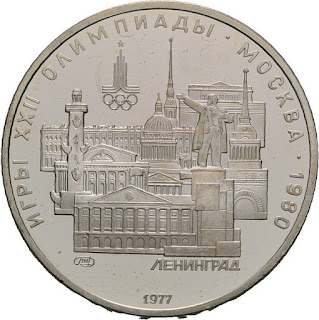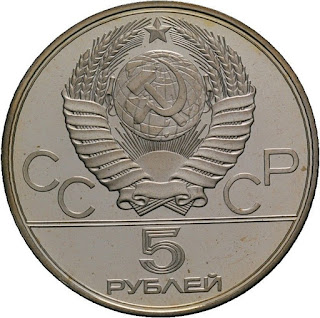USSR 5 Rubles Silver Coin 1977 Leningrad 1980 Olympic Games in Moscow
Commemorative issue: Games of the 22nd Olympiad in Moscow.
Obverse Design: The USSR’s emblem, the Red Star surrounding the globe, 15 turns of ribbon representing the 15 republics of the Union, the legend, in Cyrillic script, meaning: “U.S.S.R. 5 Roubles”.
Artist: L.S. Kamshilov and P.K. Potapov, modelers.
Reverse: A view of Leningrad: Admiralty building, Smolny and monument to Vladimir Lenin, Winter Palace, Rostral column, the Olympic emblem and the legend, in Cyrillic script, meaning: “The XXII Olympiad Moscow 1980” and the year 1977.
Artist: V.V. Nikitin.
Edge: Milled.
Mintage: (Proof) 121,417.
Mintage: (Uncirculated) 250,411.
Diameter: 33 mm.
Weight: 16.67 grams.
Thickness: 2.4 mm.
Composition: .900 silver and .100 copper.
Mint Mark: Leningrad and Moscow Mint’s Mintmark.
Struck by Leningrad and Moscow Mint.
Leningrad - Saint Petersburg
Leningrad - Saint Petersburg (Russian: Санкт-Петербу́рг, tr. Sankt-Peterburg) is the second largest city in Russia, politically incorporated as a federal subject (a federal city). It is located on the Neva River at the head of the Gulf of Finland on the Baltic Sea. In 1914 the name of the city was changed from Saint Petersburg to Petrograd (Russian: Петроград), in 1924 to Leningrad (Russian: Ленинград), and in 1991, back to Saint Petersburg. In Russian literature, informal documents, and discourse, the word "Saint" is usually omitted, leaving "Petersburg". In casual conversation Russians may drop the "burg" as well, referring to it as "Piter".
Saint Petersburg was founded by Tsar Peter the Great on May 27 [O.S. 16] 1703. Between 1713–1728 and 1732–1918, Saint Petersburg was the imperial capital of Russia. In 1918, the central government bodies moved from Saint Petersburg (then named Petrograd) to Moscow. It is Russia's 2nd largest city after Moscow with 5 million inhabitants (2012) and the fourth most populated federal subject. Saint Petersburg is a major European cultural center, and also an important Russian port on the Baltic Sea.
Saint Petersburg is often described as the most Westernized city of Russia, as well as its cultural capital. It is the northernmost city in the world with a population of over one million. The Historic Centre of Saint Petersburg and Related Groups of Monuments constitute a UNESCO World Heritage Site. Saint Petersburg is also home to The Hermitage, one of the largest art museums in the world. A large number of foreign consulates, international corporations, banks, and other businesses are located in Saint Petersburg.
Moscow-1980 Olympic Coins
The Moscow Olympics were the first Olympic games to be held in a socialist country. An Act of the Soviet government authorized the Ministry of Finance and the State Bank of the USSR to issue a 28-coin collection of five and ten roubles in proof and uncirculated qualities. There was also six proof and six uncirculated gold 100 roubles, five proof and five uncirculated platinum 150 roubles, and six proof and six uncirculated 1 rouble coins.
1 Rouble 1979 University of Moscow 1 Rouble 1980 Monument of Yuri Dolgorukiy 1 Rouble 1979 Monument to the Conquerors of Space
Geographic Series
Silver 5 Rubles 1977 Tallinn Silver 5 Rubles 1977 Minsk Silver 5 Rubles 1977 Kiev Silver 5 Rubles 1977 Leningrad Silver 10 Rubles 1977 Moscow Kremlin
The Olympic motto is the hendiatris Citius, Altius, Fortius, which is Latin for "Faster, Higher, Stronger." The motto was proposed by Pierre de Coubertin on the creation of the International Olympic Committee in 1894.
Series – "Citius" Faster
Series – "Altius" Higher
Series – "Fortius" Stronger
Series – Sports and grace
Series – Folk sports
Olympic Gold Coins
Gold 100 Rubles 1977 Sport and Peace symbol Gold 100 Rubles 1980 Olympic Flame Gold 100 Rubles 1978 Central Lenin Stadium Gold 100 Rubles 1978 Krylatskoye Rowing Canal Gold 100 Rubles 1979 Druzhba Multipurpose Arena
Olympic Platinum Coins
Platinum 150 Rubles 1979 Chariot racing Platinum 150 Rubles 1978 Discobolus Platinum 150 Rubles 1979 Ancient Greek wrestlers

